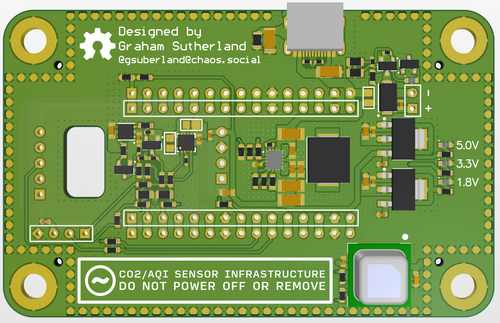Air Quality Monitoring Pledge Drive
Air quality monitoring allows you to make informed decisions about your health and well being. The hackspace is running a pledge drive to fund the building and installation of these.
We currently monitor some basic things like temperature, humidity (and soon barometric pressure). These can be queried from Discord or viewed on Cacti. The pandemic notably demonstrated the importance of maintaining good air quality, promoting good ventilation, leading to reduced rates of infections from airborne viruses. There are a few areas where this could be problematic, such as during film nights in the Comfy Area, random food events in the Kitchen, members meetings in the Blue Room, as well as smaller multi-occupancy rooms such as the Craft Room. The hackspace (obviously) also provides access to many tools which generate large amounts of fine airborne particles. Making data about these invisible hazards will allow hackspace members to make informed decisions about their health.

For EMF Camp 2022 and 2024, Graham Sutherland designed and built a number of air quality monitors which were installed across the camp site. Graham has kindly agreed to help with this project by re-using the design, with some changes to better fit the hackspace's requirements.
Graham's air quality monitoring boards are equipped with the following sensors:
- SHT35 for high precision temperature and humidity.
- SCD40 for CO2. This part uses a dual-sensor NDIR design which improves reliability and helps limit drift. Monitoring CO2 levels in a room the recommended way of managing the spread of airborne viruses such as COVID.
- SGP30 for Volatile Organic Compounds (VOCs), such as ethanol fumes. In addition to TVOC readings, this sensor also outputs eCO2 (equivalent CO2) which is a measurement of how much CO2 is expected to have been produced in conjunction with the measured TVOC levels in a combustion reaction, which can help distinguish human exhalation from other CO2 sources.
- PMSA003 for small particles, such as counts for PM1.0, PM2.5, PM5.0 and PM10 (varying sizes of particles in the air). These are not present directly on the boards but can be optionally wired to a header. These stats will be available on two of the modules as it costs a bit extra.
The new metrics will be available in the same places as temperature and humidity, either with a discord command or through Cacti (there might also be plans to deploy Grafana, which will provide a much more friendly view of our instrumentation metrics).
Each air quality monitor will cost roughly £70 and we'd like to run a pledge drive for the construction and installation of these. This includes the board, components, and materials to laser cut some enclosures. The following areas have been identified as good locations for sensors:
Air quality monitoring is cool on its own, but if you contribute £30 or more to the pledge drive we will engrave your name on one (or more) of the sensors. For the six sensors we've listed above, we are hoping to raise £450. If we raise more than this, we can build additional sensors for areas like the Studio, Electronics Area, one or more for the workshop, etc. These areas are larger and less of a priority.
Pledge
If you'd like to contribute to the pledge drive, please add your name to the table below, along with the amount you're pledging. If you are unable to login to the Wiki, or struggling to edit the table, please email your pledge to the trustees (trustees@nottinghack.org.uk)
Please do not make your payment until contacted.
| Who | How Much | Paid? | Method Paid |
|---|---|---|---|
| Aaron Jackson | £100 | No | |
| Emily Roe | £30 | No | |
| Shane | £15 | No | |
| 'RepRap' Matt | £5 | No | |
| JonW | £20 | No | |
| Tony Shannon | £30 | No | |
| Toby T (non-member) | £40 | No | |
| Howard Smith | £5 | No | |
| Mark Hollowell | £20 | No | |
| Graham Sutherland | £20 | No | |
| Eddie Podgorski | £30 | No | |
| Simon T | £5 | No | |
| Bob Wood | £10 | No | |
| Parsnip | £10 | No | |
| Jason Alexander | £20 | No | |
| Betty Ching | £20 | No |